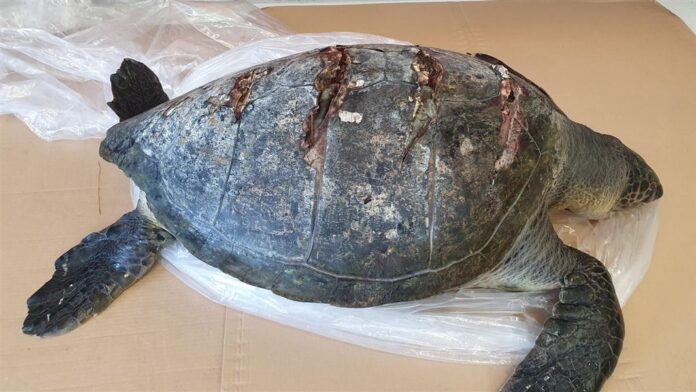Source: Department of Conservation
Date: 26 January 2021
The call comes after a dead black sea turtle (a subspecies of green turtle) was found washed ashore on Whangaparaoa beach north of Auckland with four deep cuts from a propeller in its shell. A necropsy was completed by the Auckland Zoo.
DOC Biodiversity Supervisor, Molly Hicks says, “The results of the necropsy indicate the turtle was likely to have been alive when struck by the boat, and the boat strike caused bleeding in its lungs.
“The Hauraki Gulf is extremely busy this Summer season, especially with increased visitor numbers and the America’s Cup. We want to remind people we share this beautiful ocean space with other living species that need to be considered at all times.”
A week after this incident Auckland Whale and Dolphin Safari reported observing a seriously injured common dolphin.
Auckland Whale and Dolphin Safari skipper, Gary Williams says “We were disappointed, but sadly not surprised, to come across a common dolphin showing serious ‘prop strike’ wounds on a recent safari.
“When we’re out on the water it’s so important to remember we are guests in these animals’ natural environment. All of us are responsible for looking out for marine mammals and helping protect them.”
All reptiles, including sea turtles are protected under the Wildlife Act 1953 and all seals, sea lions, dolphins and whales are protected under the Marine Mammals Protection Act 1978. It’s an offence to harass, disturb, injure or kill marine mammals and sea turtles.
Molly says “We encourage those who are interested in viewing marine mammals and reptiles to consider seeking out a licensed tour operator who are trained to interact safely with marine mammals.
If you come across injured or stranded marine mammals and reptiles call 0800 DOC HOT (0800 362 468).”
More about green turtles
Green turtles (chelonia mydas) are the only herbivorous turtle, feeding mostly on seagrasses, algae and mangroves. They also eat fish and their eggs, jellyfish, sponges and various shellfish.
In turn they are preyed upon by many animals throughout their life cycle, including humans. They are called green turtles because of the colour of their meat when made into soup.
Some green turtles spend a part of their life cycle around the northern North Island, with individuals regularly seen at Rangaunu Harbour (Far North) and Poor Knights Islands.
These turtles are thought to come from the Indo/Western Pacific population, though some have been discovered from the Eastern Pacific population. Eastern Pacific Green turtles can be recognised by their distinctive tent-shaped carapace (particularly the females).
Green turtles are IUCN listed as Endangered (population decreasing). Coastal development and overharvesting by humans are thought to be the main causes of their decline. Some also die by ingesting plastic bags, as rubbish collects easily in the shallow harbours where they feed.
If you’re travelling at sea near marine mammals:
- travel no faster than idle or ‘no wake’ speed within 300 m
- make sure there are no more than three vessels within 300 m, including any aircraft
- stay at least 200 m away from any whale mother and calf
- approach from a direction that is parallel and slightly to the rear
- do not circle the marine mammals, obstruct their path or cut through any groups
- do not swim with whales.
- idle slowly away.
Contact
For media enquiries contact:
Email: media@doc.govt.nz



